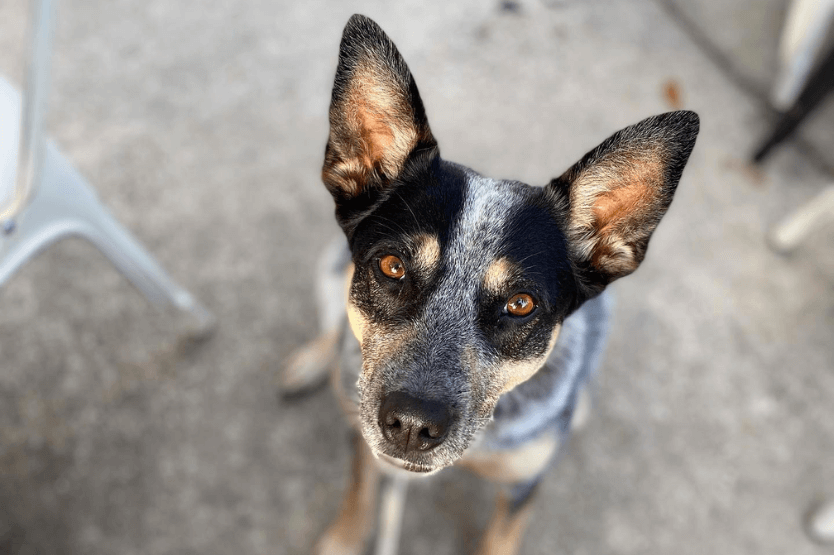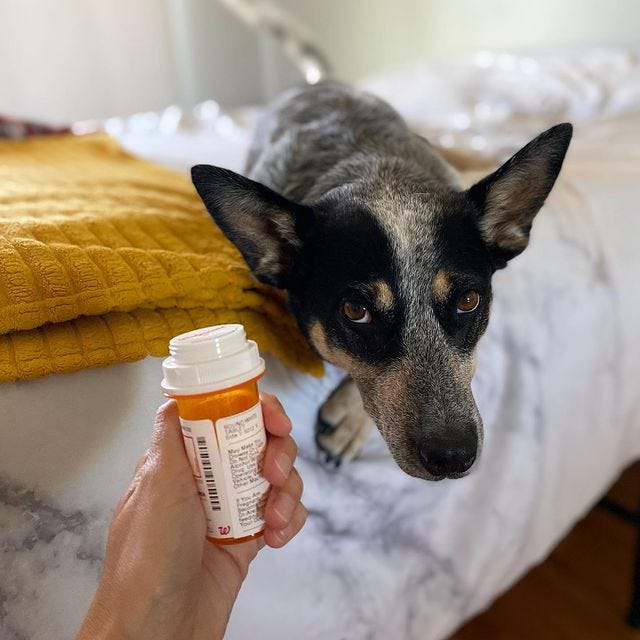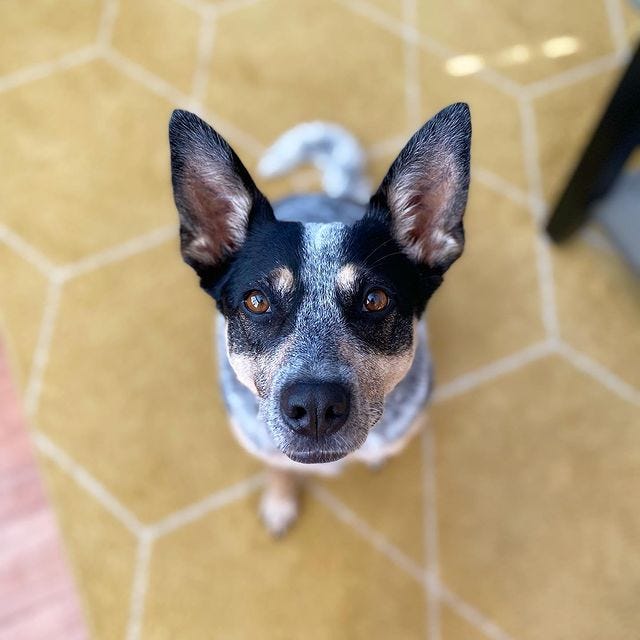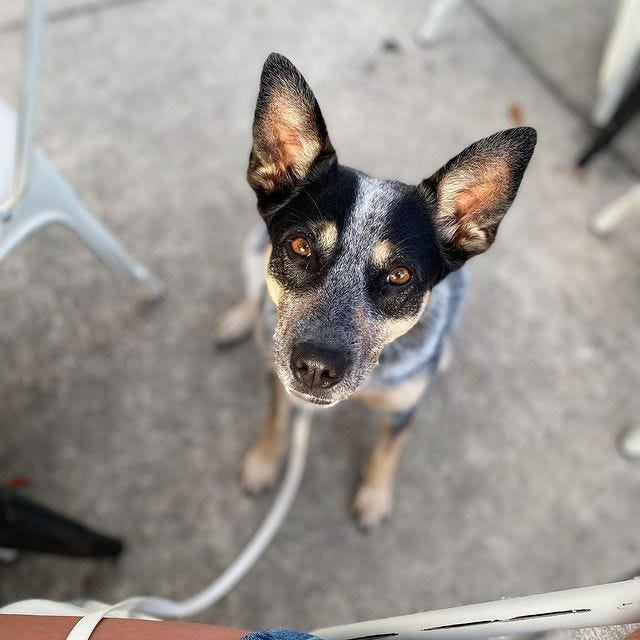An example of health affecting my dog’s behavior
I think it’s important to consider our dogs’ physical wellbeing when addressing behavioral problems. Here’s the way I think about stressors in Scout’s life through the layered stress model—and a recent example with side effects from her new seizure medication.
What is the layered stress model?
The layered stress model has been a big part of my dog ownership journey.
It’s essentially a framework illustrating how stressors “layer” on top of each other. The more capacity our dogs use on health and lifestyle problems (like physical discomfort or lack of fulfillment), the less they have to tackle other things. When we eliminate as much negative stress as possible at those foundational levels, though? We give them more bandwidth to handle additional challenges!
You can listen to Jay Jack talk about the layered stress model with Pat Stuart and Glenn Cooke from The Canine Paradigm podcast here or watch his YouTube video below.
Similar concepts to the layered stress model
If you’ve ever heard of the pile-on principle or the straw that broke the camel’s back, the layered stress model is a similar idea.
I also think it fits with the spoon theory popular in the chronic illness community. My mom has battled rheumatoid disease for over a decade—I’ve seen firsthand how bandwidth can be limited and “small” things take it up. When we aren’t at our best physically, we’re less able to thrive in other ways. The same is true for our dogs.
How I consider these ideas in life with my dog
So in order to be fair to Scout, I try to
fill her tank as much as possible,
increase her overall capacity.
This can look like a lot of things. We’ve put together a fulfillment checklist to guide our daily activities. I think critically about whether or not we should bring her into a public environment. We play and train and advocate and grow as a team.
And after three years together, life usually feels great! I’m confident about who my heeler is and what she can handle. It no longer takes a ton of guessing and rough calculations to figure out if a situation will be too much for her.
Recent example: Scout’s seizure medication side effects
Her seizure medicine has been an adjustment, though.
We put Scout on twice-daily phenobarbital to control her worsening idiopathic epilepsy earlier this month. (You can read all about our personal seizure experience here.) While we’re confident this is the right decision, it’s been an adjustment.
Anticonvulsant side effects our cattle dog is experiencing so far
She’s hungrier and thirstier, which means she has to use the bathroom more. (I’m sensitive imagining this feeling—I had chronic UTIs that culminated in a bladder surgery back in 2018, and it was miserable.)
She’s less coordinated. She still wants to play—I am so thrilled about that!—but struggles to engage in the same games with the same intensity.
She’s groggy at the height of each dose.
These are expected side effects. We’ll get used to them over time (and if we need to, we’ll tweak our treatment plan). But just because everything is “normal” doesn’t mean it’s not affecting our household!
How hunger specifically has changed our dog’s behavior
The most intense side effect we’ve seen in Scout is hunger or increased appetite.
I can’t ask exactly what she’s feeling, so it’s hard to say if she’s hungry in the acute uncomfortable sense we associate with skipping meals on a busy work day or if it’s a subtler urge to eat. Either way, she definitely wants more food.
She actually whines for meals now. We’ve intentionally never fed her at set times to avoid that anticipation (my childhood dogs used to really struggle if we got off of a specific routine).
She’s started trying to take my own snacks out of my hands. While I’ll be the first to admit we’re lax about polite begging like chin rests, we’ve never had a pushiness problem like this. Scout stole a single bite of quesadilla on only one occasion before she started her seizure medication, and we put a stop to it right away. (We do still joke that quesadillas are her favorite food though 😉)
She got into an unopened bag of kibble in her bedroom for the first time. We’ve stored our extras in the same spot for well over a year. Our cattle dog seldom gets into the trash or destroys anything without permission (like when we give her packages to help us open).
It’s important to understand where Scout is coming from
It would be easy to feel frustrated about all this—to believe our dog should know better and assume she’s being sassy or disobedient or taking advantage of us.
But I really don’t think Scout is regressing in her manners or intentionally breaking rules. I think she feels weird and is trying to make sense of this new normal.
Am I going to let her take food from people’s hands or get into the trash? Of course not! Feeling “off” isn’t a free pass to engage in dangerous behavior. (I try to remind myself of this when I’m overwhelmed and want to spiral self-destructively…)
But I’m also going to approach these new food issues with empathy. Instead of stewing in annoyance, I’m thinking about how we can address what she’s feeling to make this transition easier:
Divide her daily rations into smaller meals so she can eat more frequently
Add more low-calorie treats like veggies so she can put extra volume in her stomach without gaining weight
Provide additional chews
And so on
It won’t be perfect—nothing is—and sometimes we’re stuck between a rock and a hard place. But I’ve never regretted giving Scout the benefit of the doubt.
Other ways we’re trying to make sure we’re fair to her
Another part of acknowledging that Scout feels weird—hungry, clumsy, unfocused, maybe confused—is realizing we might simply need to ask less of her for a little while.
To be clear: I think the last thing our dog needs is less activity overall. I don’t want to treat her like she’s glass, reduce her fulfillment, or make her seizure treatment more complicated than it needs to be! (I can be an overthinker, and it’s important to stay grounded in the reality at hand.)
But I do want to be conscious of how things make her feel in this adjustment period.
For example:
We’ve skipped some of the cardio / strength public workout classes we like to attend at a nearby outdoor mall because they’re loud and require Scout to exercise more impulse control. We’re still going to our morning yoga sessions, though, because it’s a low-stress environment she seems to genuinely enjoy.
Most of our recent walks have been harness + flexi sniffaris where Scout can set the pace and explore at her leisure.
Sean and I have gone on more solo runs instead of bringing Scout on every one. If she seems tired, I don’t want to force her to keep up with us for an extended period of time.
Ultimately: What does my dog’s health mean for her stress capacity?
Whenever Scout’s behavior changes, I want to consider if she might be uncomfortable—and how I can help with that root cause.
Is she sore? Has she been sleeping well? How’s her digestion? Is it a change in medication? Have we been putting her through a lot of stressful situations lately? How do tweaks to our lifestyle influence her overall stress levels?
I usually can’t find perfect answers. (I’ll never know for sure exactly how much I should account for her seizure med side effects when considering what I ask her to do with me, for example.) But I can continue weighing things out best I can in an effort to do right by her.
And that’s what counts.








